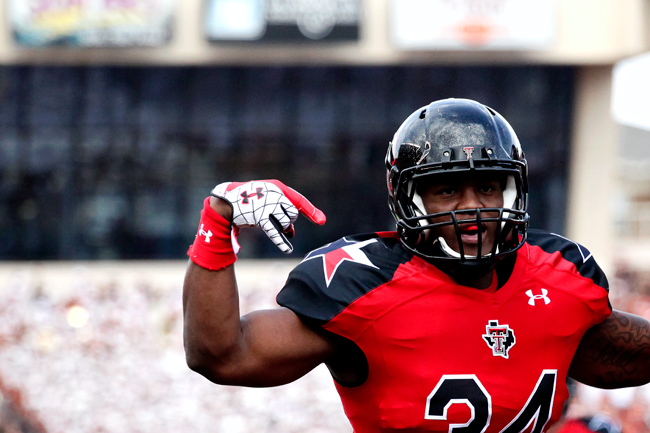History of ‘Horns Down’
Texas Tech running back Kenny Williams celebrates his first quarter touchdown with a horns down sign. It is a sign that Mack Brown labeled on Monday as disrespectful and a double standard after Mike Davis was penalized for holstering guns at the Tech crowd.
August 3, 2022
Editor’s note: This article first appeared in the August 2, 2022 flipbook.
Texas’ iconic “Hook ‘em, Horns” hand gesture has been a symbol of the University since Henry Pitts first did it in 1955.
To him, the fist with index and pinkie fingers extended resembled the Longhorns logo. Harley Clark, Texas’ head yell leader and the man who Pitts first showed the sign to, went on to announce it as “the official hand sign of the University of Texas, to be used whenever and wherever Longhorns gather” while at a rally before taking on TCU.
The Longhorns’ national success on the gridiron in the 1960s led rival schools to quickly find a comeback to the signal, which entailed simply turning the horns upside down. It’s unclear when it was first used, but The Daily Texan featured a Baylor student doing it in 1963, bringing media attention to the new phenomenon.
Nowadays, “Horns Down” is a common sight at any Texas sporting event, and even at some not involving the Longhorns at all. From Texas-Oklahoma at the Cotton Bowl to Texas A&M versus any SEC opponent, everyone seemingly wants to take a dig at one of the most recognized brands in college sports.
Over 50 years later, fans, students and even players are using the gesture to bring down the Longhorns. Recently, however, the NCAA and the Big 12 have started to crack down on unsportsmanlike conduct penalties, including the use of Horns Down from athletes during games.
Since Horns Down became an unsportsmanlike conduct penalty, the gesture has seen a ramp up in production by those who view the rule as soft. Fans often use the signal more than their own school’s when playing Texas, and even go as far as to purchase Longhorns merchandise just to turn it upside down.
“Let me be very clear with Horns Down,” said Greg Burks, the Big 12 coordinator of football officials at Big 12 Media Days. “It’s the same as all other symbols. It’s when you do it, who you do it to and in which manner you do it.”
Some schools have shown a willingness to accept a 15-yard unsportsmanlike conduct penalty for the use of Horns Down. One of the more notable examples of this was in 2018, when the West Virginia Mountaineers came to Austin for a football game. After catching a 60-yard touchdown, wide receiver David Sills V aimed a pair of Horns Down at Longhorn fans and then quickly got hit with a penalty.
Later in the same game, the Mountaineers took the lead with a two-point conversion. Quarterback Will Grier copied Sills’ double Horns Down and gave the Longhorns another free 15 yards. Karma wouldn’t catch up to the Mountaineers as this score would prove to be the deciding factor, giving West Virginia a close 42-41 road win.
More recently, in a game between Texas Tech and Texas, quarterback Alan Bowman threw a Horns Down after scoring a touchdown with three minutes remaining in the fourth quarter, extending the Red Raiders’ already big lead.
According to NBC Sports, Texas Tech had a 99.9% chance of winning the game after Bowman’s touchdown. The Longhorns, led by former quarterback Sam Ehlinger, would go on to score 22 unanswered points, including the go-ahead touchdown in overtime, to take down Bowman and the Red Raiders 63-56.
Horns Down isn’t going anywhere any time soon. Longhorns fans should expect to continue seeing the gesture at nearly every sporting event, just maybe a little less often from opposing players.



